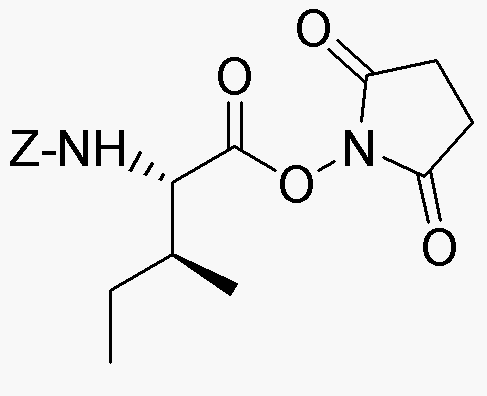Z-L-isoleucine-N-hydroxysuccinimide ester is widely utilized in research focused on:
- Peptide Synthesis: This compound serves as a valuable building block in the synthesis of peptides, allowing for the incorporation of isoleucine in various sequences, which is crucial for developing therapeutic peptides.
- Drug Development: It plays a role in the design of drug candidates, particularly in the pharmaceutical industry, where modifications to amino acids can enhance the efficacy and specificity of drugs.
- Bioconjugation: The ester functionality enables efficient bioconjugation techniques, facilitating the attachment of biomolecules to surfaces or other molecules, which is essential in creating targeted drug delivery systems.
- Research in Protein Engineering: This compound is used in studies aimed at modifying protein structures, helping researchers explore the effects of amino acid substitutions on protein function and stability.
- Diagnostic Applications: Its derivatives are being investigated for use in diagnostic assays, where specific binding interactions can be leveraged to improve the sensitivity and specificity of tests.
General Information
Properties
Safety and Regulations
Applications
Z-L-isoleucine-N-hydroxysuccinimide ester is widely utilized in research focused on:
- Peptide Synthesis: This compound serves as a valuable building block in the synthesis of peptides, allowing for the incorporation of isoleucine in various sequences, which is crucial for developing therapeutic peptides.
- Drug Development: It plays a role in the design of drug candidates, particularly in the pharmaceutical industry, where modifications to amino acids can enhance the efficacy and specificity of drugs.
- Bioconjugation: The ester functionality enables efficient bioconjugation techniques, facilitating the attachment of biomolecules to surfaces or other molecules, which is essential in creating targeted drug delivery systems.
- Research in Protein Engineering: This compound is used in studies aimed at modifying protein structures, helping researchers explore the effects of amino acid substitutions on protein function and stability.
- Diagnostic Applications: Its derivatives are being investigated for use in diagnostic assays, where specific binding interactions can be leveraged to improve the sensitivity and specificity of tests.
Documents
Safety Data Sheets (SDS)
The SDS provides comprehensive safety information on handling, storage, and disposal of the product.
Product Specification (PS)
The PS provides a comprehensive breakdown of the product’s properties, including chemical composition, physical state, purity, and storage requirements. It also details acceptable quality ranges and the product's intended applications.
Certificates of Analysis (COA)
Search for Certificates of Analysis (COA) by entering the products Lot Number. Lot and Batch Numbers can be found on a product’s label following the words ‘Lot’ or ‘Batch’.
Numéro de catalogue
Numéro de lot/série
Certificates Of Origin (COO)
This COO confirms the country where the product was manufactured, and also details the materials and components used in it and whether it is derived from natural, synthetic, or other specific sources. This certificate may be required for customs, trade, and regulatory compliance.
Numéro de catalogue
Numéro de lot/série
Safety Data Sheets (SDS)
The SDS provides comprehensive safety information on handling, storage, and disposal of the product.
DownloadProduct Specification (PS)
The PS provides a comprehensive breakdown of the product’s properties, including chemical composition, physical state, purity, and storage requirements. It also details acceptable quality ranges and the product's intended applications.
DownloadCertificates of Analysis (COA)
Search for Certificates of Analysis (COA) by entering the products Lot Number. Lot and Batch Numbers can be found on a product’s label following the words ‘Lot’ or ‘Batch’.
Numéro de catalogue
Numéro de lot/série
Certificates Of Origin (COO)
This COO confirms the country where the product was manufactured, and also details the materials and components used in it and whether it is derived from natural, synthetic, or other specific sources. This certificate may be required for customs, trade, and regulatory compliance.


